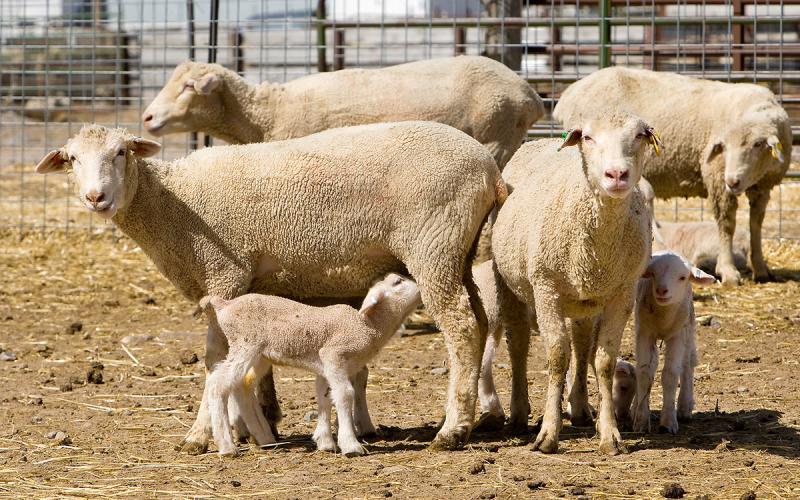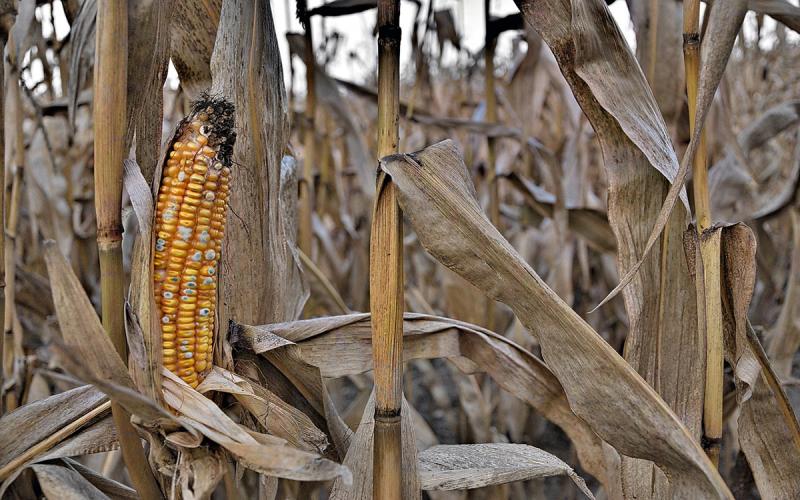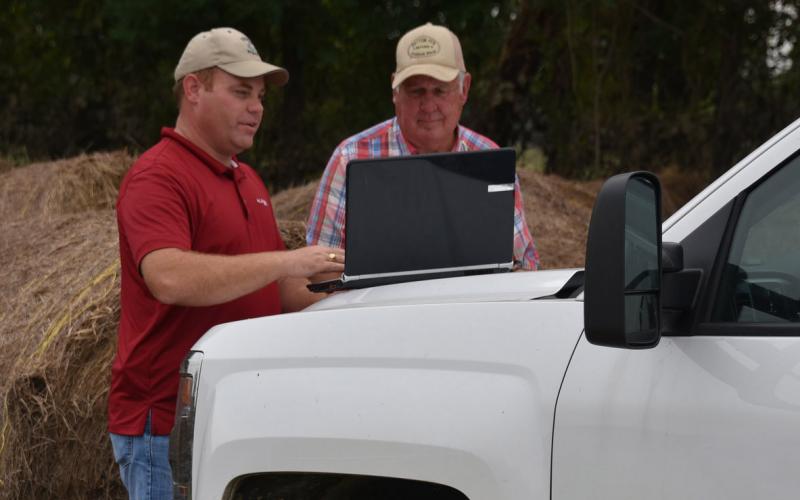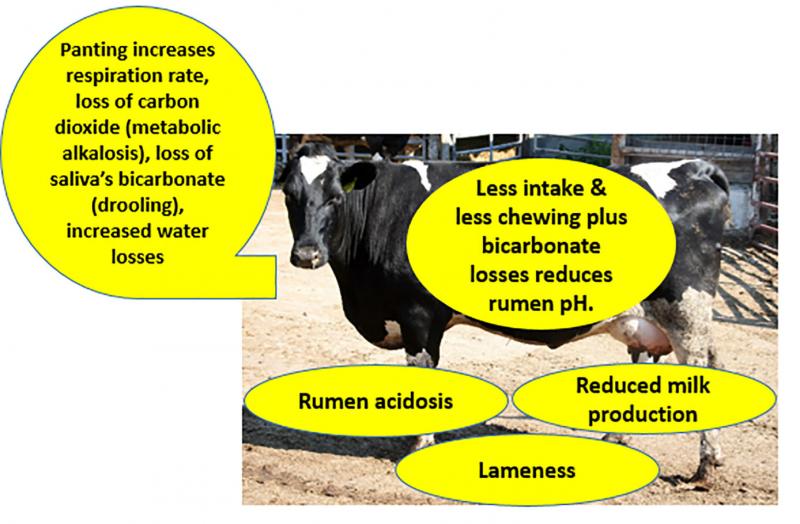
Originally authored by Alvaro Garcia, former SDSU Extension Agriculture & Natural Resources Program Director.
Alleviating heat stress is critical to milk production. Heat stress from high environmental temperatures can be compounded by mistakes in managing and feeding cows. Water is your first concern during periods of high temperatures. Water physical properties—heat conductivity and latent heat of vaporization—help transfer heat from the body of the animal to the environment. Dry matter intake of lactating cattle is affected when ambient temperatures are outside of the cow’s “comfort zone” (41 to 68 F). When ambient temperatures increase beyond 68 F, the cow typically goes off feed.
Dry matter intake can decrease by 0.17 pounds for each degree above 68 F. During severe heat stress, total intake and milk production may decrease by more than 25 percent. It is estimated that for every 1-pound decrease in dry matter intake 2 pounds of milk production are lost. Some responses of cattle to heat stress, such as panting, may actually increase heat production in their bodies. Other changes, such as reduced dry matter intake, selective consumption (higher energy dense feeds), reduced activity, reduced metabolic rate, and cooling strategies, will reduce heat production.
Reducing Heat Stress
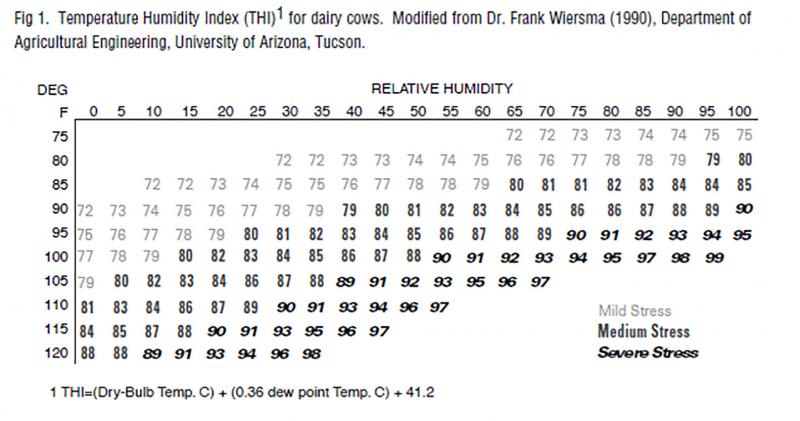
Water requirements parallel the increase in ambient temperature. As the temperature rises from 86 to 95 F, water intake may increase from 21 to 32 gallons. If cows have access to an outside lot, it is very important that the water be close to shade and the feed bunk. Higher producing cows are more prone to suffer from heat stress because they generate more heat as a result of their higher feed intake and thus will require more drinking water. The water should be fresh, clean, and free of contaminants. If you are using well water, have it tested for its safety for cattle. Try to keep cows that are on outside lots or pasture away from ponds. Ponds pose a risk to cattle health: They often have poor quality water, and they also can increase the incidence of mastitis and higher somatic cell counts in your herd. Under current drought conditions, if cows are drinking water from sources that are not rural water systems, it is necessary to run a “livestock suitability test” (sodium, alkalinity, sulfates, nitrate nitrogen, electrical conductivity and hardness) to determine if it is safe for livestock. Contact your SDSU Extension Field Specialists for more details.
Close confinement in the holding pen contributes to heat stress. You might be able to cool your cows by a combination of air movement (fans) and water or shade. Sprinkling the cows lightly, without also providing adequate air circulation, can worsen the situation by creating a hot and humid environment that will not allow heat to dissipate. This is shown in Figure 1, where 95 F and 85 percent relative humidity result in medium heat stress. The same temperature (95 F), with 91 percent relative humidity index results in severe heat stress. Increasing airflow by the addition of fans is a partial solution to this problem. Shading from direct sunlight is also very important.
Research data are limited as to the benefit of shade, but in one Arizona study, shade over the feed bunimproved milk production by 7.5 percent as compared to a control situation with no shade. During summer months, cows provided with no shade consumed 18% more water per day than cows given shade. Permanent shades can sometimes be a problem as they can concentrate moisture and manure and might increase the incidence of mastitis. Portable shade systems can be constructed with either wood or welded pipes. Shade cloth that provides at least 80 percent shade is available. Shading the feed manger increases cow comfort while eating and may encourage higher feed intakes. A combination of a sprinkler system spraying toward the cows and fans to increase airflow can be used to dissipate the heat from the cow. Spray water away from the feed so that it does not become wet. Try always to keep udders dry to decrease the incidence of mastitis. Make sure there is enough traction in the floor to prevent injuries due to slipping.
Heat Stress and the Diet
Heat is produced as a result of microbial fermentation in the reticulo-rumen. Low quality, stemmy forages generate more heat of fermentation inside the animal, contributing to the animal’s total heat load. Heat is used to maintain body temperature when ambient temperatures are low (below 40 F). But when ambient temperatures are high the cow needs to maintain its body temperature within biological limits compatible with life. Her options are limited. She can drink more fresh water (water evaporation from the body dissipates heat). She can look for cool spots like ponds, shade, and places with good air circulation, or she can decrease her dry matter intake.
High-quality forages are digested faster and result in less heat being produced. So, whenever feed intake decreases due to heat stress, consider enriching the ration. Energy is a particular concern, as most of it is derived from the fermentation of forages within the rumen. Increasing the energy density might require greater amounts of concentrate and/or byproducts. But keep in mind that shifting the grain/forage ratio may increase the risk of not having enough rumen “scratch factor” (effective fiber) to optimize rumination. When the rumen mat formation is inadequate, saliva production decreases (less chewing activity). This decreases rumen pH and allows more grain to be fermented in the abomasum and intestines. Adequate particle size and the use of buffers such as sodium bicarbonate are critical in these “hot rations” to minimize the risk of digestive disorders such as acidosis and displaced abomasum. Sweating aids in heat dissipation, and sodium and potassium are secreted in sweat. This will be a problem particularly with high producing dairy cows, which secrete more of these minerals in milk. When environmental temperatures are above 86 F, make sure that diets contain at least .25 pounds of white salt per cow per day. Plenty of fresh, high quality water should also be available. Test it; you don’t want water already high in sodium.
Alleviating heat stress in dairy cattle during the summer. Maintaining optimum nutrient balances and providing highly palatable, digestible feeds and ample supplies of fresh, clean water, along with shade and ventilation, will go far toward keeping your cows comfortable and their milk production up.
